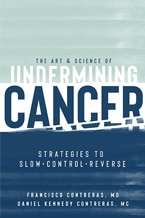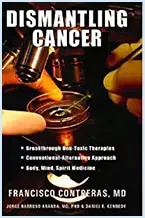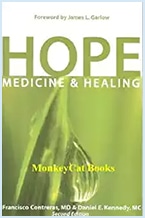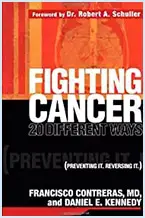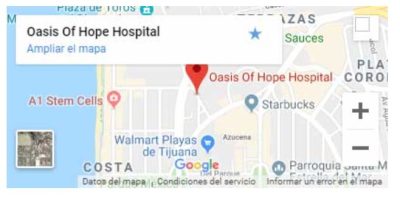Vitamin C Therapy
Available for Cancer?
The Place for Alternative Cancer
It’s a scientific fact: the antioxidant vitamin C will promote oxidation when it circulates in very high concentrations in highly oxygenated blood. Healthy cells tolerate high dosages because of catalase, an enzyme that neutralizes oxidation immediately. Catalase is abundant in our blood and normal tissues but generally scant in malignant tumors— this lack in cancerous tissues allows vitamin C’s oxidative capacity to selectively kill malignant cells.
Conventional therapy produces significant collateral damage, by which I mean that while chemotherapy, radiation, and surgery are very effective at killing cancer cells, they don’t discriminate—they also kill healthy cells, equally.
Some of the main cells that suffer are those of the immune system. Oncologists must carefully estimate what the damage will be to healthy cells to avoid killing the patient with the very treatment intended to save him.
That’s why chemo and radiation must have breaks in their cycles. I’m happy to share that there are natural therapies that produce no collateral damage. In some cases, these work as effectively as chemo while not harming the patient. I want to introduce you to one of the oncology world’s greatest secrets: high-dose intravenous vitamin C.
A Natural Anti-tumor Agent
Researchers have found that a highly concentrated vitamin C dose is “selectively” toxic to cancer cells, meaning the dose harms cancer cells but not healthy tissue. Yet when this treatment was coupled with the addition of catalase (an enzyme), the cancer-killing effect was reduced significantly. This led researchers to believe that the high-dose vitamin C infusion resulted in production of large quantities of hydrogen peroxide, which initially caused a cancer-killing effect that was then neutralized by the catalase.
This suggested that cancer cells do not produce sufficient catalase to neutralize high levels of hydrogen peroxide on their own.
We now know that many cancer cells produce small amounts of catalase to sustain low concentrations of hydrogen peroxide. This creates the cancer-friendly environment of mild oxidative stress that encourages rapid growth of and further aggression by malignant cells. Fortunately, because a high proportion of cancers are only able to produce small amounts of catalase, they’re vulnerable to the cancer-killing effect exhibited by high levels of hydrogen peroxide.
A high dose and rapid IV infusion of vitamin C reacts spontaneously with molecular oxygen within tumors, generating large amounts of hydrogen peroxide, lethal to tumor cells that produce only small amounts of catalase.
The NIH research has proven that to consistently achieve the vitamin-C concentration sufficient to provoke oxidation, a patient must receive dozens of grams intravenously; oral administration is useless in this regard. In addition, for the therapy to be effective, it should be given with a protocol that includes Ozone therapy.
Many published case reports, which show that repeated high-dose IV treatments yield objective tumor regression, are so compelling that NIH clinical trials are formally evaluating intravenous vitamin C therapy. Currently, we continue to look at dosing and treatment intervals as studies suggest that multiple, staged, and intermittent treatments may produce better anti-tumor effects than long high-dose single treatments. This will also protect the kidneys from becoming saturated. At Oasis of Hope we’re utilizing protocols with multiple treatments and pauses between doses to maintain the level of vitamin C within an optimal therapeutic window.
In theory, high-dose vitamin C should not cause toxic damage to healthy tissue because the body produces sufficient amounts of catalase to efficiently neutralize the hydrogen peroxide produced. Our experience supports the theory. We’ve treated hundreds of patients in this manner with no side effects, and our current protocol ensures vitamin-C blood and tissue levels that are safe and effective to kill cancer cells.
Yet a burning question remains. Why doesn’t this therapy work for everyone? Three variables can undermine its effectiveness.
- First, some tumors produce larger amounts of catalase, which neutralizes the oxidizing effect of hydrogen peroxide.
- Second, sometimes there are insufficient catalysts to promote the necessary transfer of electrons.
- Third, sometimes in the extracellular space there is insufficient oxygen, which is needed for vitamin C to produce hydrogen peroxide.
For now, scientists have not found a way to selectively block production of catalase within tumors. However, we can definitively increase this therapy’s effectiveness by providing two supporting agents: electron transfer catalysts and tumor oxygenating agents.
Vitamin C Therapy
Dr. Contreras explains one of the oxidative treatments used at Oasis of Hope, that people sometimes confuse. Vitamin C is consider as an anti-oxidative elements; however, when administered at high doses, such as 1 gr per minute and when combine with oxygen, it creates Peroxide, the natural killing agent of malignant cancerous cells.
Specific Benefits: Vitamins C and K3
Vitamin C’s ability to generate hydrogen peroxide in tumors hinges on the presence of catalysts that can transfer electrons from the vitamin to oxygen molecules, generating an unstable compound superoxide, which rapidly converts to the hydrogen peroxide that has cancer-killing properties.
One such well-known catalyst is menadione, also known as vitamin K3 . Substantial research in both rodent and human studies demonstrates that supplementing intravenous vitamin C with injectable vitamin K3 increases the therapy’s effectiveness on cancer cells.
A vitamin C/K3 combination can interact synergistically with certain cytotoxic chemo drugs in killing cancer cells. Vitamin K3 alone can increase the cytotoxicity of certain chemo agents, presumably because, in sufficiently high concentrations, K3 help generate oxidative stress by transferring electrons from intracellular molecules to oxygen.
At the Oasis of Hope, we inject vitamin K3 just prior to the vitamin C infusions, with the hope and expectation that C/K3 combination will markedly increase the production of hydrogen peroxide within tumors, enabling a more substantial cell kill in those cancers that produce sufficiently small amounts of catalase.
While vitamin K3 is an excellent electron transfer catalyst, the effectiveness of intravenous vitamin C therapy can still be crippled if oxygen levels within the tumor are poor. (Remember: Many common tumors create a hypoxic environment, so it’s necessary to introduce agents that can efficiently oxygenate them.)
We continue to use vitamin C in cancer treatment and am optimistic because the research community is seriously looking again at its action as a pro-drug to deliver malignant-cell-killing hydrogen peroxide to tissues.



